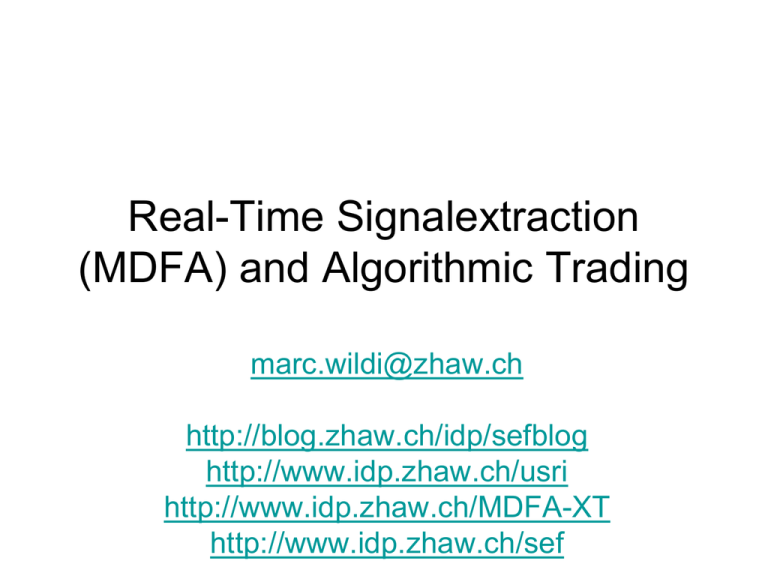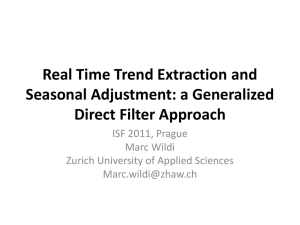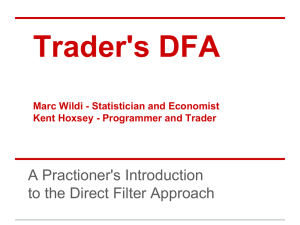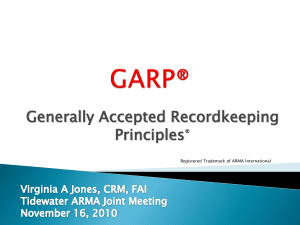ppt - R/Finance
advertisement

Real-Time Signalextraction (MDFA) and Algorithmic Trading marc.wildi@zhaw.ch http://blog.zhaw.ch/idp/sefblog http://www.idp.zhaw.ch/usri http://www.idp.zhaw.ch/MDFA-XT http://www.idp.zhaw.ch/sef Background • Hybrid math/econ. • IDP-ZHAW → Projects with econ. partners • Forecasting – Health-care (cost expenditures) – Macro (real-time economic indicators: EURI Eurostatproject) – Finance (MDFA-XT, large hedge-fund) – Engineering (Telecom, load forecasts) • Eclectic/disparate range of applications • Common methodological approach(es) – In-house developments: (M)DFA – R-package “signalextraction” on CRAN A Classical Algorithmic Trading Approach Timing System SP500 Daily Closures MA(200), Equally Weighted P.5 (drawdowns), p.7 (timing system), p.10 (performance) Problem: (Too) Long Periods with Systematic Underperformance Why do Traders Frequently Adopt/Prefer Filter Crossings? Filter Characteristics Why MDFA? http://blog.zhaw.ch/idp/sefblog/index.php?/archives/54Intermezzo-Why-do-Traders-Often-Consider-Crossings-ofTrading-Filter-Pairs.html Log-MSCI and MA(45) Filter Characteristics 1 44 1 44 MA(45): log( MSCI t k ) ( )= exp(ik ) 45 k 0 45 k 0 1 44 Id-MA(45) 1-( ) = 1- exp(ik ) 45 k 0 • Amplitude function: – Which signal is extracted? • Time-shift: – How large is the delay? 1 44 |1-()| = 1- exp(ik) 45 k 0 1 44 Arg 1- exp(ik ) Arg(1-( )) 45 k 0 = Timing System (MSCI-Weekly) |1-( )| = 1- 1 199 exp(ik) 200 k 0 |1-( )| = 1- 1 199 exp(ik) 200 k 0 Arg(1-( )) |1-( )| |1-( )| = 1- 1 199 exp(ik) 200 k 0 More General Crossings: MA(45,black)-MA(22,red)=crossing (blue) Conclusions • Crossing-rules are (an unnecessarily cumbersome way of implementing) bandpass filters • Crossing-rules (bandpass) have small time delays • Why MDFA? – Flexible efficient real-time (bandpass) design – Fast and smooth Fundamental Trading http://www.idp.zhaw.ch/usri SP500 http://blog.zhaw.ch/idp/sefblog USRI (MDFA) and SP500 Performance in Logs Student Thesis p.19 Long Term Performances Fundam. Trading Conclusion • Damp or avoid all massive recession draw-downs effectively – Ideal for risk-averse investors (pension funds) • Fundamental Trading: truly out of sample – Focus on Macro-data (finance data ignored) – NBER • Disadvantage: `insufficiently active’ – Texto: «Difficult to justify fees» MDFA-XT http://www.idp.zhaw.ch/MDFA-XT MSCI (+BRIC) http://blog.zhaw.ch/idp/sefblog Log-MSCI and MA(45) MDFA vs. MA(45) weekly data MDFA (blue) Faster Five Trading Filters Different Trading Frequencies Filter « Unfrequent » Filter « Unfrequent to Mid» Filter « Mid » Filter « Frequent » Conclusion • Higher trading frequencies are associated with – Bandpass shifted to the right • More flexible than traditional filter-crossings – Smaller delays/time shifts Performances Setting • Total degenerative trading costs of 0.3% per order (small fund) • Long only • No risk free interest rates Performance « Unfrequent » Performance « Unfrequent to Mid» Performance « Mid» Performance « Mid to Frequent » Performance « Frequent » Conclusions • Higher trading frequencies are associated with – Slight reduction of performance – Larger draw-downs • USRI would avoid draw-downs and then the performance would improve – Increased market activity (fees!) • Combination with USRI possible (recommended) • Filters will be available on-line in late July Real-Time Signalextraction A SEF-Blog Excel-Tutorial http://blog.zhaw.ch/idp/sefblog Excel-Tutorial on SEF-Blog • http://blog.zhaw.ch/idp/sefblog/index.php?/ archives/65-Real-Time-Detection-ofTurning-Points-a-Tutorial-Part-I-MeanSquare-Error-Norm.html • http://blog.zhaw.ch/idp/sefblog/index.php?/ archives/67-Real-Time-Detection-ofTurning-Points-a-Tutorial-Part-IIEmphasizing-Turning-Points.html Purposes • Yoga exercises to detach from main-stream maximum likelihood world • First Blog-entry: how traditional econometric approach `works’ – Intuitively straightforward – Good (optimal) mean-square performances – People have become lazy-minded • Second Blog-Entry: the early detection of turning points – Is a (strongly) counterintuitive exercise – Generates seemingly (strongly) misspecified filter designs • Warning → Learning (→ Illumination?) Excel-Tutorial on SEF-Blog AR(1) pole: argument pole: magnitude 0 0.9 Normalization AR(1) 0.1 0.9 AR(2) pole 1: argument pole 1: magnitude pole 2: argument pole 2: magnitude Normalization AR(1) AR(2) ARMA(2,2) pole 1: argument pole 1: magnitude pole 2: argument pole 2: magnitude Normalization AR(1) AR(2) 0.26179939 0.8 -0.26179939 0.8 0.1 1.54548132 -0.64 4.5 0.31415927 0.99 -0.31415927 0.99 0.06 1.8830919 -0.9801 zero 1: zero 1: zero 2: zero 2: argument 0.31415927 magnitude 0.4 argument -0.31415927 magnitude 0.4 MA(1) MA(2) 0.76084521 -0.16 10 4 8 3.5 Amplitude function AR(1) 6 2.5 Amplitude function AR(2) 4 2 Amplitude function ARMA(2,2) 2 3 1.5 Time-shift AR(1) Time-shift AR(2) Time-shift ARMA(2,2) Frequency-cycle Frequency-cycle 1 2.99 2.81 2.64 2.46 2.29 2.11 1.94 1.76 1.58 1.41 1.23 0.7 1.06 0.88 0.53 -2 0.35 0 0.5 0.18 0 2.7 2.94 2.45 2.21 1.96 1.72 1.47 1.23 0.98 0.74 0.49 0 0.25 0 -4 4 1.5 3 1 Peak Correlation AR(1) 2 1 Filtered time series ARMA(2,2) Peak Correlation AR(2) 0.5 0 Peak Correlation ARMA(2,2)) 0 -2 -1 0 -0.5 1 2 3 4 5 6 7 8 9 10 Peak Correlation ModelBased ARMA(2,2) (Rpackage) 1 -1 -2 -3 -4 -1 30 59 88 117 146 175 204 233 262 291 320 349 378 Model-based MMSE Real-time estimate from R 0 1 2 3 4 5 6 7 8 9 10 11 12 13 14 15 16 17 18 19 20 21 22 23 24 25 26 27 28 29 30 31 32 33 34 35 36 37 38 39 40 41 42 43 44 45 46 47 48 49 50 51 52 53 54 55 56 57 58 59 60 61 62 63 64 65 66 67 68 Frequencies 0 0.00628319 0.01256637 0.01884956 0.02513274 0.03141593 0.03769911 0.0439823 0.05026548 0.05654867 0.06283185 0.06911504 0.07539822 0.08168141 0.08796459 0.09424778 0.10053096 0.10681415 0.11309734 0.11938052 0.12566371 0.13194689 0.13823008 0.14451326 0.15079645 0.15707963 0.16336282 0.169646 0.17592919 0.18221237 0.18849556 0.19477874 0.20106193 0.20734512 0.2136283 0.21991149 0.22619467 0.23247786 0.23876104 0.24504423 0.25132741 0.2576106 0.26389378 0.27017697 0.27646015 0.28274334 0.28902652 0.29530971 0.30159289 0.30787608 0.31415927 0.32044245 0.32672564 0.33300882 0.33929201 0.34557519 0.35185838 0.35814156 0.36442475 0.37070793 0.37699112 0.3832743 0.38955749 0.39584067 0.40212386 0.40840704 0.41469023 0.42097342 0.4272566 exp(-iomega) 1 0.999980260856137+6.28314396555895E-003i 0.999921044203816+1.25660398833526E-002i 0.999822352380809+1.88484397154082E-002i 0.9996841892833+2.51300954433374E-002i 0.999506560365732+3.14107590781283E-002i 0.999289472640589+3.76901826699345E-002i 0.999032934678125+4.39681183178649E-002i 0.998736956606017+5.02443181797696E-002i 0.998401550108975+5.65185344820245E-002i 0.998026728428272+6.27905195293134E-002i 0.997612506361225+6.90600257144057E-002i 0.997158900260614+7.53268055279327E-002i 0.99666592803403+8.15906115681575E-002i 0.996133609143173+8.78511965507432E-002i 0.99556196460308+9.41083133185143E-002i 0.9949510169813+0.100361714851215i 0.994300790396999+0.10661115427526i 0.993611310520008+0.112856384873482i 0.992882604569814+0.11909716009487i 0.992114701314478+0.125333233564305i 0.991307631069507+0.131564359092282i 0.990461425696651+0.137790290684638i 0.989576118602651+0.144010782552252i 0.988651744737914+0.150225589120757i 0.987688340595138+0.156434465040231i 0.986685944207868+0.162637165194883i 0.985644595148998+0.168833444712734i 0.984564334529205+0.175023058975276i 0.98344520499533+0.181205763627137i 0.982287250728689+0.187381314585725i 0.981090517443334+0.19354946805086i 0.979855052384247+0.199709980514407i 0.978580904325472+0.205862608769881i 0.977268123568193+0.212007109922055i 0.975916761938747+0.218143241396543i 0.974526872786577+0.224270760949381i 0.973098510982127+0.230389426676591i 0.971631732914674+0.236498997023724i 0.970126596490106+0.242599230795408i 0.968583161128631+0.248689887164854i 0.967001487762435+0.254770725683382i 0.965381638833274+0.260841506289897i 0.96372367829001+0.266901989320375i 0.962027671586086+0.272951935517325i 0.960293685676943+0.278991106039229i 0.958521789017376+0.285019262469976i 0.95671205155883+0.291036166828272i 0.954864544746643+0.297041581577035i 0.952979341517219+0.303035269632774i 0.951056516295154+0.309016994374947i 0.949096144990295+0.314986519655305i 0.947098304994744+0.32094360980721i 0.945063075179805+0.326888029654942i 0.942990535892864+0.332819544522987i 0.940880768954226+0.338737920245291i 0.938733857653874+0.344642923174517i 0.936549886748193+0.350534320191259i 0.934328942456612+0.356411878713251i 0.932071112458211+0.362275366704546i 0.929776485888251+0.368124552684678i 0.927445153334661+0.373959205737801i 0.925077206834458+0.379779095521801i 0.922672739870115+0.385583992277397i 0.92023184736587+0.391373666837203i 0.917754625683981+0.397147890634781i 0.915241172620917+0.402906435713663i 0.912691587403503+0.408649074736349i 0.910105970684996+0.414375580993284i Real-Time Signalextraction 1. Traditional Econometrics Task: Extract the Cycle Signal: Ct k X t k k T 1 ˆ ˆ X Estimate: C k t k T k 0 Standard Econometric Approach • Proceeding: – Identify a time-series model (ARIMA/state space) – Extend the series by optimal forecasts – Apply the symmetric filter on the extended time series • X-12-ARIMA, TRAMO, STAMP, R/S+… • Claim: – One-sided filter is optimal (mean-square sense) – Assumption: DGP/true model ARMA(2,2)-Diagnostics Real-Time Model-Based Filter Real-Time Signalextraction 2. Excel Example (Replication of Model-Based Approach) Parameters (ARMA(2,2)-FILTER) • ARMA(2,2)-Filter (not model) ARMA(2,2) pole 1: argument 0.26179939 zero 1: argument 0.26179939 pole 1: magnitude 0.99 zero 1: magnitude 0.9 pole 2: argument -0.26179939 zero 2: argument -0.26179939 pole 2: magnitude 0.99 zero 2: magnitude 0.9 Normalization 0.11 AR(1) 1.91253314 MA(1) 1.73866649 AR(2) -0.9801 MA(2) -0.81 A Seemingly Virtuous Design (amplitude) 1.2 1 0.8 Amplitude function ARMA(2,2) 0.6 Frequency-cycle 0.4 0.2 3.02 2.76 2.51 2.26 2.01 1.76 1.51 1.26 1.01 0.75 0.5 0.25 0 0 A Seemingly Virtuous Design (time shift) 5 4 3 2 -2 -3 -4 3.1 2.94 2.78 2.61 2.45 2.29 2.12 1.96 1.8 1.63 1.47 1.31 1.14 0.98 0.82 0.65 -1 0.49 Frequency-cycle 0.33 0 0.16 Time-shift ARMA(2,2) 0 1 A Seemingly Virtuous Design (Peak Correlation) • Correlation between real-time estimate and cycle as a function of time-lag k 1.2 1 0.8 0.6 0.4 Peak Correlation ARMA(2,2)) 0.2 0 -0.2 -0.4 -0.6 -0.8 -1 -2 -1 0 1 2 3 4 5 6 7 8 9 10 1 T (k ) 1 T T Cˆ C j k 1 T j |k |1 j j k ,k 0 Cˆ j |k |C j , k 0 Signal and Estimate (Estimate: Filter Tweaked by Hand) 4 3 2 1 Filtered time series ARMA(2,2) 0 1 -1 -2 -3 -4 27 53 79 105 131 157 183 209 235 261 287 313 339 365 391 Cycle Real-Time Signalextraction 3. Excel Example (Turning Point Revelation) Parameters ARMA(2,2)-FILTER Seemingly Misspecified Design • ARMA(2,2)-Filter (not model) ARMA(2,2) pole 1: argument 0.31415927 zero 1: argument pole 1: magnitude 0.99 zero 1: magnitude pole 2: argument -0.31415927 zero 2: argument pole 2: magnitude 0.99 zero 2: magnitude Normalization 0.06 AR(1) 1.8830919 MA(1) AR(2) -0.9801 MA(2) 0.31415927 0.4 -0.31415927 0.4 0.76084521 -0.16 A Seemingly Misspecified Design Amplitude 4.5 4 3.5 3 Amplitude function ARMA(2,2) 2.5 2 Frequency-cycle 1.5 1 0.5 3.02 2.76 2.51 2.26 2.01 1.76 1.51 1.26 1.01 0.75 0.5 0.25 0 0 A Seemingly Misspecified Design Time Shift 7 6 5 4 3 Time-shift ARMA(2,2) 2 Frequency-cycle 1 -2 -3 3.1 2.94 2.78 2.61 2.45 2.29 2.12 1.96 1.8 1.63 1.47 1.31 1.14 0.98 0.82 0.65 0.49 0.33 -1 0.16 0 0 A Seemingly Misspecified Design Peak-Correlations 1.5 1 Peak Correlation ARMA(2,2)) 0.5 0 -2 -1 -0.5 -1 0 1 2 3 4 5 6 7 8 9 10 Peak Correlation Model-Based ARMA(2,2) (Rpackage) A Seemingly Misspecified Design Filtered Series and Signal 4 3 2 1 Filtered time series ARMA(2,2) 0 1 -1 -2 -3 -4 26 51 76 101 126 151 176 201 226 251 276 301 326 351 376 401 Cycle Comparison: Seemingly Virtuous vs. Seemingly Misspecified 4 3 2 1 Misspecified ARMA(2,2) 0 1 -1 -2 -3 -4 32 63 94 125 156 187 218 249 280 311 342 373 Model-based ARMA(2,2) Comparison: Seemingly Virtuous vs. Seemingly Misspecified 3 2 1 Misspecified ARMA(2,2) 0 1 4 7 10 13 16 19 22 25 28 31 34 37 40 43 46 49 52 -1 -2 -3 Model-based ARMA(2,2) Conclusions • Seemingly misspecified design is – Faster – Smoother (less false TP’s or “alarms”) – Not mean-square optimal – Much better in a TP-perspective From Excel to MDFA • Tweak filter parameters `by hand’ in Excel Tutorial • Shortcomings of example – Unrealistically simple artificial simulation exercise – In practice: • more complex nuisances and/or signals – Include information from more than one time series (multivariate framework) • Wish: a formal optimization criterion • Welcome to DFA and MDFA DFA Direct Filter Approach Mean-Square DFA: Direct Filter Approach E[(Yt Y t ) ] min( filter _ parameters) 2 • Idea: estimate mean-square filter error efficiently T 1 E[(Yt Y t )2 ] (Yt Y t ) 2 eT T t 1 2 T (T 1)/2 k (T 1)/2 | (k ) (k ) | ITX (k ) eT ' 2 Optimization Criterion (I(0)) 2 T (T 1) / 2 k (T 1) / 2 | (k ) (k ) | ITX (k ) Min 2 • Minimize a (uniformly) superconsistent estimate of an (uniformly) efficient estimate of the filter mean-square error • (Customized) Efficiency enters explicitly in the Design of the Optimization Criterion Did You Say and/or Mean “Periodogram”? • Periodogram is a typical example of “statisticbashing” – Inconsistent estimate of spectral density – Smoothing (parametric or non-parametric) • Periodogram has wonderful statistical properties – Sufficiency (Larry Brethorst) – One can derive nice formal efficiency results in realtime signalextraction • Working on a series of new Blog entries about the topic to rehabilitate – to some extent … - the periodogram Performances (Efficiency of Univariate DFA) • Business Survey Data (KOF, FED, 2004,2005) – X-12-ARIMA, Tramo/Seats – MSE-gain ~30% • US- and Euro-GDP (2008): – CF – turning-points anticipated by 1-2 quarters • ESI (2006): – Dainties – TP‘s discovered 2-3 months earlier Performances (Efficiency) by Relying on the Periodogram • TP-filters won NN3 (2007) and NN5 (2008) forecasting competitions (~60 participants) – IIF and University of Lancaster – Monthly Macro- and Financial Data (111 time series) and daily financial data (111 time series) – Outperformed winner and runner-up of prestigious M3 competition, X-12-ARIMA, Tramo, Forecast-Pro, Autobox, Exponential smoothing: Simple, Holt, Damped,… – Neural nets, artificial intelligence – http://blog.zhaw.ch/idp/sefblog DFA Direct Filter Approach Turning Points (TP) Controlling the Time Delay (Customization) [T / 2] 2 ˆ ( ) |2 I ( ) | ( ) A k k NX k T k 0 min ˆ 2 [T / 2] 2 A( ) Aˆ ( )(1 cos( ˆ ( )))I ( ) k k k NX k k 0 T •λ>1: emphasize the time delay in the pass-band •λ=1: best level filter Customization: Controlling time delay and smoothness 2 [T / 2] 2 ˆ ( ) |2 I ( ) W ( ) | ( ) A k k k NX k T k 0 min ˆ 2 [T / 2] 2W ( ) 2 A( ) Aˆ ( )(1 cos( ˆ ( )))I ( ) k k k k NX k k 0 T • Stronger damping of highfrequency noise in stop-band • Smaller time delays in pass-band • W(ω) is monotonic (increasing) and λ>1 W ( ) Amplitude DFA TP-filter (blue) vs. seem. virtuous level filter (KOFBarometer) Delay TP-filter (blue) vs. seem. Virtuous level filter (KOF-Barometer) TP-Detection • Smoother and Faster! • Poor Mean-Square Performances MDFA Real-Time Multivariate Filter X t ,W1t ,...,Wmt , t 1,..., T rt k k X t k Target: Yt k k X t k ˆ ˆ ˆ 0 k X t k 1kW1,t k ... mkWm ,t k k 0 k 0 k 0 Objective: choose ˆik such that rt 2 is smallest possible E[rt ]FILTERWEIGHTS Min 2 •`Direct Filter Approach’ Real-Time Filter Cointegration Constraints (Rank=1) Ct X t 1W1t ... mWmt rt =((0)-ˆ (0))X t ˆ 1 (0)W1t ... ˆ m (0)Wmt Z t I(0) I(0) Zt ((0)-ˆ (0))X t ˆ 1 (0)W1t ... ˆ m (0)Wmt ˆ i (0) i ((0)-ˆ (0)) I(0) I(0) Efficiency (Theorem 4.1, Wildi2008, Wildi/Sturm2008) 2 T (T 1) / 2 k (T 1) / 2 | Tr '(k ) | E[rt ] eT 2 2 • The error term eT is smallest possible uniformly • Uniform efficiency ↔ Customization Optimal (Efficient) Criterion under Cointegration (Rank=1) •Filter Restrictions are satisfied 2 T (T 1) / 2 k (T 1) / 2 | Tr '(k ) |2 Min (0) exp(ik )(k ) Tr '(k ) (0)TC (k ) exp(ik ) (0) T X (k ) 1 exp(ik ) (0) exp(ik )(k ) (0) T X (k ) 1 exp(ik ) ˆ h (0) exp(ik )ˆ h (k ) h (0) T Wh (k ) 1 exp(ik ) h 1 m Performances MDFA • Output-gap US- and Euro-GDP (2008): – CF and multivariate CF – turning-points anticipated by 1-2 quarters • USRI – Outperformed Markov-switching (Chauvet, Chauvet/Piger), Dynamic factor models (CFNAI), state space models (ADS), HodrickPrescott (OECD-CLI), Christiano-Fitzgerald – SEF-Blog • MDFA-XT • EURI WARNING!!! • THIS IS NOT A PUSH-THE-BUTTON APPROACH • Formula 1 racer: it can be fast (Ferrari) and reliable (Mercedes) but you have to tweak it carefully: Ferrades/Mercearri – – – – Filter design (ZPC) Filter constraints (emphasize frequency zero) Understanding/interpreting: `intelligence’ 2008-Book: http://www.idp.zhaw.ch/sef • Happy to provide support given financial incentives Contact/Links Contact/Links • marc.wildi@zhaw.ch • http://blog.zhaw.ch/idp/sefblog – Illustrate methodological issues by relying on `realworld‘ projects with economic partners • http://www.idp.zhaw.ch/usri – Real-Time US Recession Indicator • http://www.idp.zhaw.ch/MDFA-XT – Experimental Trader for MSCI Emerging Markets – Filters on-line late July • http://www.idp.zhaw.ch/sef – Signal Extraction & Forecasting Site – Books, Articles, Software











